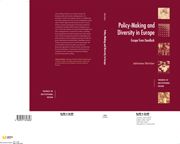Book contents
- Frontmatter
- Contents
- Acknowledgements
- 1 Escaping deadlock: policy-making in Europe
- 2 The context of subterfuge: diversity, fragmentation and the malleability of the European polity
- 3 The analytical approach and theoretical background
- 4 Market-making policy: transport and telecommunications
- 5 The provision of collective goods and the reduction of externalities: environmental policy
- 6 Market-correcting, redistributive policy: regional and social policy
- 7 Market-correcting, distributive policy: research and technology
- 8 Summary and conclusion: stalemate and subterfuge across policy areas
- References
- Index
7 - Market-correcting, distributive policy: research and technology
Published online by Cambridge University Press: 22 September 2009
- Frontmatter
- Contents
- Acknowledgements
- 1 Escaping deadlock: policy-making in Europe
- 2 The context of subterfuge: diversity, fragmentation and the malleability of the European polity
- 3 The analytical approach and theoretical background
- 4 Market-making policy: transport and telecommunications
- 5 The provision of collective goods and the reduction of externalities: environmental policy
- 6 Market-correcting, redistributive policy: regional and social policy
- 7 Market-correcting, distributive policy: research and technology
- 8 Summary and conclusion: stalemate and subterfuge across policy areas
- References
- Index
Summary
European research and technology policy has been slow to develop for a variety of reasons. Foremost, policy-makers were confronted with various possible lines of action. They could stick to their own national prosgrammes, opt for voluntary intergovernmental co-operation with other European and non-European governments, or establish a common policy to pool resources and establish a supranational authority in research and technology policy (Eberlein and Grande 1997). Although there is general agreement that joint activities would be advantageous for Europe's competitive position on the world market, initial attempts at co-operation failed. As a result, a striking discrepancy emerged between general commitment to closer European co-operation, on the one hand, and the prevalence of national policies, on the other, leaving scant room for a European research and technology policy. With the Single European Act and the Maastricht Treaty the EU received more extensive political power in the fields of research and technology policy. It was given the task of strengthening the scientific and technological bases of European industry so as to make the latter more competitive in international markets (Sandholtz 1992). Thus, the goals of research and technology and industrial policy are closely linked (Peterson 1996; Lawton 1997). In 1994 the Council passed the Fourth Action Programme providing 12.3 billion ECU for the development of research and technology for the period 1994–8 (Byström 1996).
- Type
- Chapter
- Information
- Policy-Making and Diversity in EuropeEscape from Deadlock, pp. 80 - 86Publisher: Cambridge University PressPrint publication year: 1999



